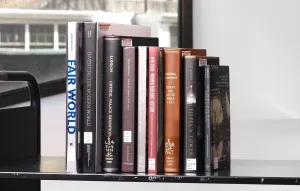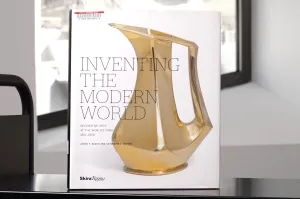Reading List: World's Fairs
March 10, 2022
By Eugénie Fortier, Acting Storage and Retrieval Lead, Frick Art Reference Library
Since 1851, World’s Fairs have showcased industrial, artistic, and technological progress, introducing cutting-edge advancements and world culture to a global audience. Fairs, which typically last six months, are also known as Expositions Universelles, International Expositions, and, more recently, World Expos. Host nations create elaborate temporary cities that feature large exhibition halls as well as pavilions sponsored by participating countries. These spectacular events are sometimes memorialized by now iconic landmarks such as the Eiffel Tower in Paris, the Unisphere in New York City, and the Space Needle in Seattle.
To coincide with Expo 2020 in Dubai—delayed due to the pandemic and running from October 2021 through March 31, 2022—this recommended reading list features publications in the Frick Art Reference Library’s collections that span the 171-year history of this tradition. The titles below explore topics of representation and perception, cross-cultural exchange, innovation, and progress through the visual culture of the World’s Fairs.
For further reading on the topic from the library’s collections, check out our World’s Fairs research guide. Visit our reading room at Frick Madison by making an appointment to consult these books and more.
-
Fair World: A History of World’s Fairs and Expositions from London to Shanghai, 1851–2010
By Paul Greenhalgh (2011)
Explore the legacy of international exhibitions in this richly illustrated publication that offers a comprehensive view of the process of mounting such elaborate, yet temporary, microcosms of the world. The text traces the evolution of World’s Fairs from their golden age between 1875 and 1915, when more than fifty exhibitions were held, to conceptions of the future on view at fairs in the mid-twentieth century to today. The cultural, social, economic, and political impacts of World’s Fairs are discussed, providing a thorough study of the benefits and consequences of such large-scale exhibitions.
-
The Crystal Palace Exhibition: Illustrated Catalogue, London 1851
By Dover Publications (1970)
Rediscover the advancements in industry and art that dazzled guests at the Great Exhibition of 1851 in London, renowned for being the first World’s Fair. This popular catalog, reproduced from the event, features over 1,500 engravings of the items displayed and sold at the iconic Crystal Palace, so named because of its ultra-modern sheet glass and iron construction. Objects range from quotidian articles such as shoes, shaving razors, and tableware to lavish pianos, sculptures, and tiaras. Completing the catalog are essays on new inventions in textile machinery, the impact of science and botany on art and manufacturing, color theory, and aesthetic taste.
-
Latin America at Fin-de-Siècle Universal Exhibitions: Modern Cultures of Visuality
By Alejandra Uslenghi (2016)
This title considers how Latin American countries presented their national identities in visual forms at three monumental World’s Fairs. Sponsored exhibits from Brazil, Mexico, and Argentina at Philadelphia’s Centennial International Exposition of 1876 used the newfound medium of photography as both a documentary and artistic medium to offer glimpses of the nations’ landscapes, modernizing cities, and traditional iconography. In the Exposition Universelle of 1889 in Paris, fifteen Latin American countries displayed nationalism through their pavilions’ architecture, which ranged from recreations of ancient ruins to industrial constructions of iron and glass. The narratives of Latin American travel writers as shown at the 1900 Exposition Universelle reveal the influence of cinema on literature, charting the intersection between urbanism, modernity, and new ways of seeing. Throughout this enlightening text, Uslenghi interweaves these perceptions of Latin America with the realities of the region’s political and social climates.
-
New York Crystal Palace 1853: Digital Publication
By Bard Graduate Center (2017)
Travel back in time and experience the New York Crystal Palace from 1853 through this digital publication that accompanied Bard Graduate Center’s 2017 exhibition on the first American World’s Fair. Along with critical essays, visitors can browse through a virtual collection of exhibited objects and fair paraphernalia, explore a panoramic rendering of the exhibition hall, take a detailed look at the guidebook, and listen to audio guides related to three individuals’ personal experiences of the spectacular event. This immersive look at one of New York City’s first tourist attractions relays the myriad consumer goods, technological advancements, and sculptures that the original visitors encountered.
-
Designing Tomorrow: America’s World’s Fairs of the 1930s
Edited by Robert Rydell (2010)
This catalog explores six international exhibitions that helped the United States recover from the Great Depression. Accompanying an exhibition at the National Building Museum in Washington, D.C., this collection of essays analyzes how World’s Fairs between 1933 and 1940, which were attended by tens of millions of visitors, presented a modern and progressive United States. While placing itself on par with Western Europe with its display of Old Master artworks on an international stage, the U.S. also presented itself as forward thinking, with streamlined designs that heralded a new “pan-American” style of architecture. This text contemplates the true meaning of modernity beyond the futuristic monuments of Depression-era World’s Fairs and examines its reaches in society, architecture, and culture.
-
Women Building History: Public Art at the 1893 Columbian Exposition
By Wanda M. Corn (2011)
Learn about the socially progressive Woman’s Building, entirely conceptualized and built by women, at the World’s Columbian Exposition held in Chicago in 1893. Echoing the exposition’s theme of man’s cultural evolution, a series of murals that embellished the neoclassical structure depicted a female-centered view of history. The public display portrayed modern women with agency, as seen in their direct gazes, contemporary clothes, and engagement in extra-domestic activities. This text examines how these murals—which celebrated the accomplishments of women, their entry into higher education, as well as their contributions to the arts and sciences—still conformed to traditional gender roles, complicating the perception of the ideal post-Victorian woman.
-
Eiffel’s Tower: And the World’s Fair Where Buffalo Bill Beguiled Paris, the Artists Quarreled, and Thomas Edison Became a Count
By Jill Jonnes (2009)
In this enthralling narrative, Jonnes delves into the controversy caused by the construction of the Eiffel Tower, which was created as a monumental entrance to the 1889 Exposition Universelle in Paris. The author sets this dramatic tale against a backdrop of various concurrent events at the international exhibition, namely shows in which Buffalo Bill and Annie Oakley introduced particular notions of the American West, the presentation of Thomas Edison’s invention of the phonograph, and a burgeoning new style of journalism. The reactions of visitors to this global showcase—including artists James McNeill Whistler, Paul Gauguin, and Vincent van Gogh—are also explored.
-
Man and His World
By International Exhibitions Bureau (1967)
Peruse this original catalog for the international exhibition of fine arts from Expo 67, held in Montreal, Canada. Beginning with the representation of human subjects as a means to examine identity, depictions of Egyptian pharaohs intermingle with portraits by Old Masters, including, notably, Margaret, the Artist’s Wife by Jan van Eyck. Further themes related to human activities, emotions, conflicts, and ideals are explored through this encyclopedic exhibition of paintings and sculptures, which ultimately sought to serve as a reminder of the universality of art.
-
JapanAmerica: Points of Contact, 1876–1970
By Herbert F. Johnson Museum of Art, Cornell University (2016)
This book assesses how the exposure of Japanese aesthetics to the global stage impacted American art and design. The 1876 Centennial Exhibition in Philadelphia, held shortly after the reopening of Japan’s international trade, led to a craze for collecting Japanese wares that was mirrored in the consumption and use of Japanese objects, motifs, and techniques in American fine arts and crafts. Accompanying an exhibition held at Cornell University’s Herbert F. Johnson Museum of Art and at the Crocker Art Museum in Sacramento, this catalog delves into the reciprocal relationship between Japanese and American aesthetics, spanning the initial 1876 introduction through Expo ’70 in Osaka.
-
Inventing the Modern World: Decorative Arts at the World’s Fairs, 1851–1939
By Jason T. Busch and Catherine L. Futter (2012)
Examine how the decorative arts shown at World’s Fairs exemplified the events’ merging of artistic and technological innovation. The authors of this book invite readers to observe cross-cultural influences across textiles, ceramics, jewelry, glass, metalwork, and furniture over time. Published in conjunction with an exhibition held at The Nelson-Atkins Museum of Art and the Carnegie Museum of Art, this catalog brings together over two hundred decorative arts objects from private and public collections that appeared in World’s Fairs, allowing the reader to consider how the display and sale of such objects at international exhibitions led to the global democratization of design.
All photos by Joseph Coscia Jr., The Frick Collection






